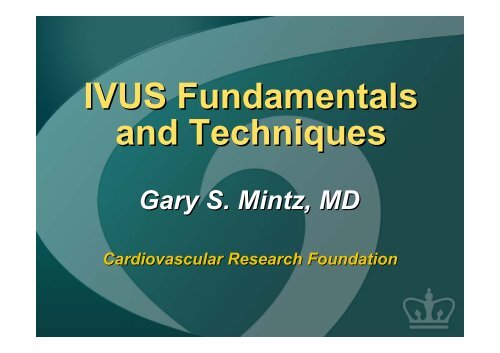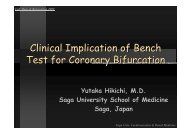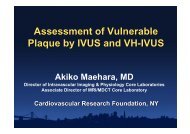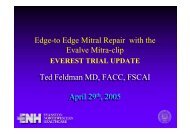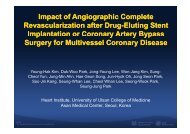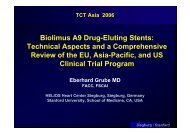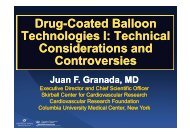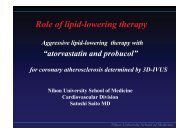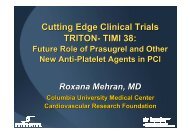IVUS Fundamentals and Techniques - summitMD.com
IVUS Fundamentals and Techniques - summitMD.com
IVUS Fundamentals and Techniques - summitMD.com
Create successful ePaper yourself
Turn your PDF publications into a flip-book with our unique Google optimized e-Paper software.
<strong>IVUS</strong> <strong>Fundamentals</strong><br />
<strong>and</strong> <strong>Techniques</strong><br />
Gary S. Mintz, MD<br />
Cardiovascular Research Foundation
• An <strong>IVUS</strong> image is not identical to histology.<br />
• Ultrasound images are produced by passing an electrical<br />
current through the transducer that exp<strong>and</strong>s <strong>and</strong> contracts<br />
to produce sound waves<br />
• Ultrasound is reflected at interfaces between tissues or<br />
structures of different density.<br />
• After reflection from tissue, ultrasound waves return to the<br />
same transducer to create an electrical impulse that is then<br />
converted into the image.<br />
• The <strong>IVUS</strong> greyscale image is derived from the amplitude of<br />
the reflected signal, not its radiofrequency. . A white image<br />
means that more of the signal is reflected <strong>and</strong> the amplitude<br />
is greater; a black image means that less of the signal is<br />
reflected <strong>and</strong> the amplitude is less.
There are two types of imaging<br />
systems: Rotating Transducer <strong>and</strong><br />
Electronic Array<br />
Rotating Element<br />
Drive Shaft<br />
Multi-element Array<br />
There are differences in catheter h<strong>and</strong>ling, system<br />
controls, <strong>and</strong> image presentation; however, both<br />
produce similar useful clinical information
Near Field <strong>and</strong> Far Field<br />
• The <strong>IVUS</strong> beam remains fairly parallel for a distance<br />
(Near Field) <strong>and</strong> then begins to diverge (Far Field).<br />
• Image quality is better in the Near Field than in the Far<br />
field.<br />
• The length of the near field is expressed by the<br />
equation L = r 2 / λ, , where L is the length of the near<br />
field, r is the radius (aperture) of the transducer, <strong>and</strong> λ<br />
is the wavelength.
• Spatial resolution<br />
• Contrast resolution
Spatial Resolution<br />
• Ability to discriminate small adjacent objects<br />
• For <strong>IVUS</strong>, the typical resolution is 80-100 microns axially<br />
<strong>and</strong> 200-250 250 microns laterally<br />
• Ultrasound cannot reliably detect or measure a structure<br />
that is smaller than its resolution.<br />
• Resolution affects the sharpness of an image, the<br />
distinctness of the borders, <strong>and</strong> the reproducibility of the<br />
measurements.<br />
• Resolution increases as transducer frequency increases;<br />
resolution decreases as transducer frequency decreases.<br />
• Resolution is better in the Near Field than in the Far fField<br />
• Focusing the transducer also improves resolution within<br />
the focused zone; however, the beam then diverges <strong>and</strong><br />
resolution suffers.
Axial resolution - along<br />
the ultrasound beam (or<br />
radius of the artery)<br />
Circumferential<br />
resolution - along the<br />
circumference of the<br />
artery - is affected by<br />
NURD<br />
Lateral resolution -<br />
along the long axis of<br />
the artery - is affected<br />
by pullback <strong>and</strong> beam<br />
width
Penetration<br />
• Penetration depends on power output, aperture,<br />
<strong>and</strong> design of the transducer <strong>and</strong> on imaging<br />
frequency. . .<br />
• Penetration is inversely related to frequency<br />
• The higher the transducer frequency, the less<br />
the penetration<br />
• The lower the transducer frequency, the<br />
greater the penetration
Transducer Selection<br />
• Larger transducers with lower frequencies are better<br />
for examination of large vessels because they create<br />
a deeper Near Field, have greater penetration, <strong>and</strong><br />
resolution is not as critical.<br />
• Smaller transducers with higher frequencies are used<br />
for small vessels where resolution is more critical <strong>and</strong><br />
penetration is less important<br />
• Theoretically, you should select the highest<br />
frequency transducer that will adequately penetrate<br />
the vessel. In practice, you choices are limited by the<br />
what is <strong>com</strong>mercially available.
Contrast Resolution<br />
• Contrast resolution = dynamic range = the<br />
number of shades of grey that can be<br />
differentiated between the weakest <strong>and</strong> the<br />
strongest targets.<br />
• The greater the dynamic range, the broader the range<br />
of reflected signals (from weakest to strongest) that<br />
can be detected, displayed, <strong>and</strong> differentiated<br />
• Low dynamic range images appear “black <strong>and</strong><br />
white” with only a few “in between” gray-scale<br />
levels – in other words, they appear “contrasty”<br />
• High dynamic range images have more shades of<br />
grey <strong>and</strong> can differentiate more different tissue<br />
types <strong>and</strong> more structural elements.
Low dynamic range<br />
High dynamic range
Blood Speckle<br />
• The intensity of the blood speckle increases<br />
exponentially with<br />
• The frequency of the transducer: the higher<br />
the frequency, the greater the resolution;<br />
<strong>and</strong> the smaller the targets that are seen<br />
• Stasis (because of red cell clumping or<br />
rouleaux formation) - most evident when<br />
the catheter is across a tight stenosis. . In<br />
fact, static blood can be more echodense<br />
than plaque.
Controls<br />
• Other than the overall gain settings, adjusting the<br />
various system controls should be kept to a<br />
minimum.<br />
• Overall gain is useful in correcting for a weak<br />
transducer <strong>and</strong> in imaging a very large vessel with<br />
poor penetration. However, if the transducer is<br />
very weak, it is better to just get a new catheter<br />
<strong>and</strong> send the weak one back to the manufacturer.<br />
• Overall gain that is set too low limits the detection<br />
of low-amplitude signals.<br />
• Overall gain that is set too high causes all tissue to<br />
appear too bright <strong>and</strong> limits dynamic range.<br />
• Zoom or depth or scale should be set so that the<br />
entire external elastic membrane is on the screen<br />
throughout the length of the vessel.
Time Gain Compensation (TGC)<br />
• The TGC curve adjusts the image brightness at fixed<br />
distances from the catheter. The best TGC curves are flat.<br />
• Increasing the far-field field intensity slightly is useful in<br />
imaging large vessels.<br />
• Excessive reduction in near field intensity to reduce blood<br />
speckle, ring down, or other near field artifacts can also<br />
blank out tissue <strong>and</strong> artificially produce a lumen. If blood<br />
speckle can be seen in the lumen, it is less likely that near-<br />
field tissue will be blanked out.
Only a small percentage of the emitted signal<br />
returns to the transducer to create the image.<br />
The amplitude of the reflected signal<br />
depends on<br />
• Amplitude of the transmitted signal<br />
• Distance from the transducer to the target<br />
• Angle of the signal relative to the target<br />
• Density (or reflectivity) of the tissue.<br />
• Attenuation of the signal as it passes through<br />
tissue<br />
• As the wave passes through many tissue interfaces, the<br />
energy is attenuated (reduced). Attenuation is a function<br />
of the number <strong>and</strong> characteristics of the tissue<br />
interfaces as well as some scattering <strong>and</strong> absorption
Intima, , Media, <strong>and</strong> Adventitia<br />
• In normal arteries, the material that most strongly<br />
reflects ultrasound is collagen. The reflectivity of<br />
collagen is 1000 times that of muscle.<br />
‣ The adventitia of coronary arteries has high collagen<br />
content <strong>and</strong> is, therefore, echoreflective.<br />
‣ The media of coronary arteries has a low collagen<br />
content, is mostly muscular, <strong>and</strong> is typically echolucent.<br />
• The internal elastic membrane separates the intima<br />
from the media. Fibrous changes in the media make<br />
it difficult to identify the internal elastic membrane<br />
<strong>and</strong> image <strong>and</strong> quantify the media as a distinct<br />
structure.
• Intimal disease (plaque)<br />
is dense <strong>and</strong> will appear<br />
‘white’<br />
• Media is made of<br />
homogeneous smooth<br />
muscle cells <strong>and</strong> does<br />
not reflect ultrasound<br />
(appears dark)<br />
• Adventitia has ‘sheets’<br />
of collagen that reflect a<br />
lot of ultrasound<br />
(appears white)
Principles of Measurements<br />
• Measurements made at the leading edge of an <strong>IVUS</strong><br />
target are accurate <strong>and</strong> reproducible while measurements<br />
at the trailing edge are inconsistent <strong>and</strong> frequently yield<br />
erroneous results.<br />
• Measurements should be performed relative to the center<br />
of mass of the lumen or artery, not relative to the center of<br />
the <strong>IVUS</strong> catheter.<br />
• During clinical <strong>IVUS</strong> imaging of non-stented<br />
lesions, , there<br />
are only two distinct boundaries that have consistent<br />
histologic correlates: the lumen-intima<br />
(or lumen/plaque)<br />
interface <strong>and</strong> the media-adventitia adventitia interface (or external<br />
elastic membrane=EEM).<br />
• In stented vessels there can be three boundaries: EEM,<br />
stent, , <strong>and</strong> lumen dimensions.<br />
• We report plaque&media or atheroma measurements<br />
because we cannot separate the plaque from the media.
Spatial Orientation<br />
• There is no absolute (anterior versus posterior, left<br />
versus right) rotational orientation of the image.<br />
• Instead, side branches are used during clinical<br />
<strong>IVUS</strong> imaging; <strong>and</strong> the image is described as if<br />
viewing the face of a clock.<br />
• With some systems, images can be rotated<br />
electronically to produce a consistent orientation as<br />
an electronic aid to interpretation.<br />
• Perivascular l<strong>and</strong>marks are also important<br />
references for both axial position <strong>and</strong> rotational<br />
orientation within the vessel. These l<strong>and</strong>marks<br />
include the pericardium, muscle tissue, <strong>and</strong> the<br />
venous system.
LAD<br />
LCX<br />
RCA
Safety<br />
• Hausmann et al., Circulation 1995;91:623-30<br />
• 2207 <strong>IVUS</strong> studies in 28 centers<br />
• Spasm occurred in 2.9%. Complications other than spasm occurred<br />
in 0.4% that were related to <strong>IVUS</strong> <strong>and</strong> in 0.6% that had a possible<br />
relationship to <strong>IVUS</strong> (10 acute occlusions, 1 embolism, 5 dissections,<br />
ions,<br />
1 arrhythmia, <strong>and</strong> 1 thrombus). Major events occurred in 0.25% (2<br />
myocardial infarction <strong>and</strong> 3 emergency CABG).<br />
• Gorge et al., JACC 1996;27:155A.<br />
• 7085 <strong>IVUS</strong> studies at 51 centers<br />
• 10 (0.1%) major <strong>com</strong>plications other than spasm (7 dissection, 1<br />
thrombus, 1 VF, 1 severe unresponsive spasm)<br />
• Batkoff et al., CCD 1996;38:238-41.<br />
• 718 <strong>IVUS</strong> studies at 12 centers<br />
• 8 (1.1%) major <strong>com</strong>plications (4 spasm, 2 dissections, 2 guide wire w<br />
entrapments)
Artefacts<br />
• Nearfield Artefacts<br />
‣ Ringdown<br />
‣ Blood speckle. Flushing contrast or saline through the guiding<br />
catheter may clear the lumen <strong>and</strong> help to identify tissue borders.<br />
• Motion Artifacts<br />
‣ NURD (Non-Uniform Rotation Distortion) - only mechanical scanners<br />
‣ Axial (antegrade(<br />
<strong>and</strong> retrograde) catheter motion with each cardiac<br />
cycle - both mechanical <strong>and</strong> phased array scanners<br />
• Side lobes<br />
‣ More problematic with phased array scanners<br />
• Transducer position artefacts - more important in larger vessels<br />
‣ Catheter obliquity<br />
‣ Catheter eccentricity<br />
‣ Vessel curvature
Essentials of an <strong>IVUS</strong> Program<br />
• Director<br />
• Dedicated Technicians, Nurses, <strong>and</strong>/or<br />
Fellows<br />
• Image acquisition protocols <strong>and</strong><br />
st<strong>and</strong>ards<br />
• Identify ways to make imaging more<br />
efficient <strong>and</strong> effective<br />
• Reports<br />
• Housekeeping issues
Director<br />
• Overall responsibility for clinical <strong>IVUS</strong><br />
service including st<strong>and</strong>ards, protocols,<br />
<strong>and</strong> education
Dedicated Technicians*, Nurses, <strong>and</strong>/or Fellows<br />
• Knowledge of imaging systems, catheters, <strong>and</strong> imaging<br />
protocol(s)<br />
• Dedicated personnel are immediately available <strong>and</strong> flow of<br />
procedure <strong>and</strong> patient care not interrupted<br />
• System <strong>and</strong> catheter preparation<br />
• System controls <strong>and</strong> image optimization<br />
• Annotation<br />
• Make measurements, interpret images, <strong>and</strong> provide feedback to<br />
physician during procedure<br />
• Care of systems, video tapes, CDs, etc.<br />
• Keep procedure logs<br />
• Generate reports<br />
* Technicians often “run” an echo lab, why not an <strong>IVUS</strong> service
Imaging Procedure - I<br />
• Remember to give heparin prior to<br />
inserting guidewire <strong>and</strong> <strong>IVUS</strong> catheter –<br />
avoid thrombosis<br />
• Remember to give intracoronary NTG<br />
prior to imaging – avoid spasm<br />
• Remember to disengage guiding<br />
catheter when imaging aorto-ostial<br />
ostial<br />
lesions – avoid confusing the guiding<br />
catheter with the ostium
Imaging Procedure - II<br />
• St<strong>and</strong>ard image acquisition protocols needed for<br />
• Viewing, underst<strong>and</strong>ing, <strong>and</strong> <strong>com</strong>paring studies at a later date<br />
• Serial <strong>IVUS</strong> analysis<br />
• Multicenter studies (often have their own protocol)<br />
• Accurate voice annotation<br />
• Label studies <strong>com</strong>pletely<br />
• Vessel (e.g., LAD) <strong>and</strong> lesion location (e.g., proximal)<br />
• Device use<br />
• Temporal relationship between imaging run <strong>and</strong> procedure (e.g., prep<br />
re-<br />
intervention, post-stent stent #1, etc.)<br />
• Perform <strong>com</strong>plete imaging runs back to aorto-ostial ostial junction<br />
• Free look at proximal vessel <strong>and</strong> at LMCA if imaging LAD/LCX<br />
• Motorized pullback
Motorized Pullback<br />
• 0.5mm/sec is re<strong>com</strong>mended<br />
• Advantages<br />
• Steady, slow transducer pullback to avoid imaging any<br />
segment too quickly <strong>and</strong> avoid skipping any segment<br />
• Ability to concentrate on images without having to worry about<br />
catheter manipulation<br />
• Length measurements<br />
• Volume measurements<br />
• Reproducible image acquisition for multicenter <strong>and</strong> serial<br />
studies<br />
• Disadvantages<br />
• Potentially inadequate examination of important regions of<br />
interest because transducer does not remain long at any one<br />
specific site in the vessel
Manual Pullback<br />
• Advantages<br />
• Ability to concentrate on specific regions of interest by<br />
pausing the pullback at a specific location<br />
• Disadvantages<br />
• Can skip over pathology by pulling the transducer too<br />
quickly<br />
• No length or volume measurements<br />
• Antegrade <strong>and</strong> retrograde catheter movement can be<br />
confusing when study is reviewed at a later date<br />
• Impossible to pull transducer slowly <strong>and</strong> uniformly
Imaging Efficiency <strong>and</strong> Effectiveness<br />
• Perform imaging run(s), remove <strong>IVUS</strong> catheter, <strong>and</strong> make<br />
measurements from video tape or digital replay, NOT<br />
during live imaging<br />
• Less patient ischemia<br />
• More efficient use of cath lab time<br />
• Additional measurements can easily be made <strong>and</strong> additional<br />
questions easily answered<br />
• Display images on angiographic monitors<br />
• Superior monitors<br />
• Get <strong>IVUS</strong> system away from table<br />
• Requires separate roadmap or reference monitors
Basic Report<br />
• Patient demographics<br />
• Indications<br />
• Brief description of <strong>IVUS</strong> procedure<br />
• Equipment<br />
• Artery(s) imaged<br />
• Basic findings<br />
• Basic measurements (e.g., MLA, MSA, plaque<br />
burden, etc.)<br />
• Notable morphology (e.g., plaque rupture, thrombus, calcium,<br />
dissection, intramural hematoma, etc.)<br />
• Changes in therapy because of <strong>IVUS</strong> imaging<br />
• <strong>IVUS</strong>-related <strong>com</strong>plications <strong>and</strong> consequent therapy
Comprehensive Report<br />
• In addition to information contained in Basic Report. .<br />
• Pre-intervention <strong>and</strong>/or post-intervention quantitative<br />
analysis of three cardinal images slices: distal<br />
reference, lesion, proximal reference<br />
• EEM CSA<br />
• Lumen CSA<br />
• Plaque&media CSA <strong>and</strong> plaque burden<br />
• Area stenosis<br />
• Stent measurements<br />
• Lesion length
Reference<br />
Mintz GS, Nissen SE, et al. American College of<br />
Cardiology Clinical Expert Consensus Document on<br />
St<strong>and</strong>ards for Acquisition, Measurement, <strong>and</strong><br />
Reporting of Intravascular Ultrasound Studies. J Am<br />
Coll Cardiol 2001;37:1478-1492<br />
1492<br />
Mintz GS. Intracardiac Ultrasound. . Taylor <strong>and</strong> Francis.<br />
1995


